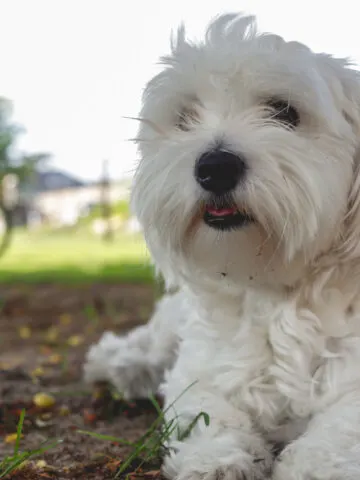When you think of a small show dog with long flowing hair and a bow on its head, a Maltese will naturally come to mind.
They actually have hair, much like ours, that grows and is easy to style as well as high maintenance. Even though this is considered a hypoallergenic breed, do Maltese still shed?
Maltese is a hypoallergenic breed, but they do, in fact, still shed, except not like other dogs. Similar to humans and how their hair strands fall out, that’s the process the Maltese go through as well.
It’s a very minuscule amount, making these dogs one of the best options for those that live with allergies.
In this article, we will talk about the Maltese breed and their shedding habits and why they’re considered a hypoallergenic breed. They’re unique in the way their hair grows and their shedding habits. Let’s get to it!
Maltese Coat
So, the Maltese will not shed a lot; however, he does shed some. Before we get into how much he loses, it’s crucial to understand the coat. This breed is a unique type of dog, and their coats are no exception.
Instead of a double coat, he has a single coat. This indicates that Maltese dogs have hair rather than just the fur that most dogs possess.
Yorkies are another breed that sheds less. The Maltese have hair that looks very similar to our own.
This is why the Maltese dog is often referred to be a hypoallergenic dog because the dander-holding underlayer does not exist. However, we’ll come back to hypoallergenic dogs eventually.
Maltese Shedding Habits
Most dogs have double coats to help regulate their core temperature and to protect them from the elements.
When the weather changes, your dog will shed, and it will require a thicker winter coat or a light summer coat. Essentially, the Maltese don’t really shed because he lacks the underlayer.
However, similar to our hair, theirs gradually falls out over the course of the year. It falls out whenever it dies, not during the summer or winter, in order to make room for new ends.
As a result, anticipate a thin coating of white hair year-round, although it won’t be noticeable.
Maltese Shedding Frequency
The Maltese do not have a regular double-coated shedding season. The Maltese, as you may well know, do not shed. He only drops a strand of hair.
He sheds a little hair year-round because he doesn’t really get prepared for changing weather.
Instead, his hair grows and grows, and it now reaches the ground. It will come to a halt when it reaches a maximum length right below his ankles, and his body will prepare to force it out.
The hair that he sheds will most certainly fade back into his coat, and you won’t notice the hair he’s lost unless you brush or wash him.
They have a crucial appeal feature in that there are no clumps of dog hair about the house. If you are don’t like dog hair, the Maltese and other hypoallergenic dogs are ideal choices.
Hypoallergenic Dogs
Hypoallergenic canines are ones that lose less fur and are more suitable to people who have mild dog sensitivities. This is due to the fact that, like the Maltese, they lack the underlayer that traps dander.
Dander is a substance made up of old hair, body oils, dead skin, and dust. Allergy responses are caused by dander, not the hair. They can also be triggered by the saliva that’s stuck to the hair, which is why shedding causes allergic reactions.
This is the reason that they are known as hypoallergenic dogs. However, contrary to popular belief, they are not completely hypoallergenic. There is no such thing as a fully hypoallergenic dog.
They’re just preferable for people with mild pet allergies because they’re less likely to trigger severe allergies. The Goldendoodle, for example, is a hypoallergenic dog that does not shed.
Bichon Frises do not shed, and their fame and shedding rates are similar to those of the Maltese.
Maltese Shedding Triggers
Stress and anxiety, among several other things, can lead to shedding and a modification in nutrition.
Given that the Maltese do not shed frequently, it is critical to notice if he begins to lose hair excessively. This isn’t typical, and it may require veterinarian assistance.
Stress is one of the most common causes of hair loss. It could be a result of things going wrong in the family home.
For example, if you’ve just returned from, or are about to return from, a vacation without him. The Maltese are delicate dogs that will pick up on your worries or shifts in the environment.
A surge in hair loss can also be an indication of pregnancy. Hair loss can occur when a mother’s hormones are out of whack. And, perhaps, her hair pattern will return to normal following the delivery of her child, as her hormones do.
Excessive Hair Loss
Severe hair loss could also be a sign of a more serious medical condition. It could be a very serious condition like hypothyroidism or cancer.
It could also be an indication of a skin illness. Other symptoms, such as fatigue, nausea, or cellulitis, are usually present.
Some Maltese shed their hair more so than others; therefore, you need to make sure you pay attention to what your Maltese regularly does. Then compare that to the frequency in which they’re shedding periodically to ensure your dog isn’t pregnant or ill.
If you notice clumps of hair or large volumes of hair left on any surface your Maltese sits on, this is a sign of excessive shedding. Since Maltese don’t shed as other dogs do, this is a very abnormal type of
Managing Your Maltese Coat
If you wash your Maltese on a continuous basis, whatever hair they shed will not be very obvious. You’re not off the leash when it comes to combing him just because he doesn’t shed. In fact, it’s the complete opposite.
To keep his long, beautiful hair appearing elegant and strong, you must trim this coat on a regular basis. Here are the most important things you can do to keep him looking wonderful.
Brushing
Brushing is perhaps the most effective and straightforward approach to keeping his coat healthy and attractive. Depending on his hairstyle, you’ll have to brush him every day or nearly every day.
Many people prefer his normal long flowing hair, but others prefer it chopped considerably shorter into a teddy bear cut. Daily brushing is required for the long Maltese coat. His tresses will work like a broom, sweeping up dirt both within the house and outside on daily walks.
It’s also more prone to twisting, which can result in matting. You will only need to brush him just a few times per week if you choose the teddy bear cut. It will gather up far less dirt and tangle far less, making it even easier.
Shampoo
Bath times for your Maltese can be made easier with the use of a sensitive skin cleanser. Finding the appropriate shampoo for his coat and skin might make a world of difference.
We recommend using a skin-sensitive shampoo created with natural ingredients since his skin is less shielded. Oatmeal shampoos are an excellent choice.
However, if your Maltese’s skin is less fragile, you might use a white dog shampoo. Many Maltese owners, particularly those whose Maltese is a show dog, opt for whitening shampoos.
You’ll need a high-quality shampoo that doesn’t include harsh bleaching chemicals if you go this route.
Some shampoos contain moisturizing agents. Conditioning elements not only make your Maltese feel silky and beautiful, but they also help to avoid clumping. When it concerns bathing him, once every two weeks or so should suffice.
Diet
The health of your Maltese’s skin and coat is also affected by his food. Not only will high-quality Maltese pet food give a well-balanced diet, but it will also provide a mixture of omega fatty acids.
These will hydrate his skin and, as a result, keep his coat looking fantastic. Fish, fish oil, egg products, flaxseed, and oils are all things to keep an eye out for. His coat will be dull and dry, given the lack of omega fats.
He will get a range of vitamins and minerals from high-quality dog treats as well. Biotin, vitamin E, and folic acid are all proven to help his skin and coat.
You will see an improvement in his coat if you currently give him store-bought food. As a result, a healthy diet, as well as plenty of fluids, will maintain his coat lustrous.
Supplements
If you can’t adjust his diet to include more omega fatty acids, giving him pills is another approach to ensure he gets them.
Fish oil supplements, which are available in pill or liquid form, are an excellent source of omega fats. Supplementing with fish oil is also beneficial to his joints, organ function, vitamin absorption, and general well-being.
Heather is an animal lover that has many of them herself. She currently has her Blue Nose Staffy named Bootsie, but she’s catered to many animals over the years including guinea pigs, alpacas, cockatiels, cockatoos, bunnies, chinchillas, hedgehogs, and more. She believes that knowledge should be the foundation of caring for any pet.



Leave a comment
You must be logged in to post a comment.